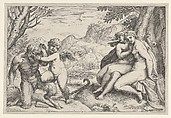Omnia Vincit Amor
Agostino Carracci Italian
Not on view
This image is a pun derived on a famous line in Virgil's tenth Eclogue, 'Love conquers all.' The Latin word omnia, like the Greek word pan, signifies 'all', while amor, the Latin name for Cupid, means 'love', so that Cupid's victorious combat with the woodland god is a visual translation of the phrase. The engraving was produced around the time that Agostino was assisting his brother Annibale in the decoration of the Farnese Gallery, a fresco cycle that also has as its theme the power of love in the universe. As a key to this meaning, Annibale had painted Cupid's successful wrestling match with Pan on one of the feigned medallions that adorn the Farnese ceiling. The subject was not a new one; it had been part of the fresco decoration of Cardinal Bibbiena's stufetta already in 1516, and had also appeared in sixteenth-century emblem books. Agostino himself had painted the battle between Pan and Cupid nearly a decade earlier in the Palazzo Magnani in Bologna.
What is unusual about Agostino's engraved version of the subject is his inclusion of the two nymphs. The only clue to their identity is provided by the head ornament of the foreground nymph, which resembles that worn by Diana in one of the scenes of the Farnese Gallery. In that episode, we see Diana about to submit to the advances of an enamored Pan, who tempts her with the offer of a beautiful piece of wool. Perhaps it is also Diana, accompanied by one of her nymphs, who appears with Pan in the engraving. The implication would be that once Pan yields to Love, the chaste Diana herself will succumb. This print is the masterpiece of the simplified and monumental manner that Agostino developed in Rome, its popularity evident from the fact that ten other printmakers are known to have copied it.
Due to rights restrictions, this image cannot be enlarged, viewed at full screen, or downloaded.


